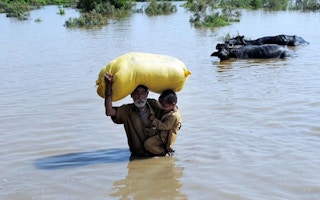Life is about to become more hazardous for more people in more places. As atmospheric carbon dioxide levels grow and the planet inexorably warms, there will be more frequent and more damaging floods, droughts and heat waves than ever before.
And since human numbers continue to soar, and the average age of many populations starts to increase, there will be more people, and a greater proportion will be increasingly vulnerable to climate extremes.
A new report by Britain’s Royal Society – one of the oldest and most prestige-laden scientific academies in the world – presents new maps that show the combined impact of climate change upon a global population that is both growing, and growing older.
Climate change is likely to be accompanied by more extremes of weather, with greater risks of flood and drought in East, West and Central Africa, India and South-east Asia. There will also be more, and more protracted heat waves: the number of such events each year could multiply threefold by 2100.
In 2003, in temperate Europe, a heat wave claimed 52,000 lives. People who are 65 or older are naturally more vulnerable to heat extremes. But because of falling birth rates and increasing lifespans, the number of 65-year-olds is also likely to increase.
So by the end of the century the combination punch of climate and demography could mean that the heat wave events experienced by older citizens could multiply by a huge range. Flood losses worldwide recently estimated at US$6bn a year could rise by 2050 to US$1trillion a year.
“
Although this affects different regions of the planet differently, one thing is for sure – what once was an extreme weather event will become more normal
Grant Allen, physicist at the University of Manchester
Harvests affected
But climate change and the weather extremes that go with it will impose another cost: at certain times it could become increasingly difficult for people to work outdoors in Africa, Asia and parts of North, South and Central America. Since the people most likely to work outdoors are farmers and farm workers, this could have an impact on the food harvest – which will anyway be at risk from flood, drought and extremes of heat.
Georgina Mace, who led the working group that produced the report, said: “We are not resilient to the extremes of weather that we experience now and many people are already extremely vulnerable.
“If we continue on our current trajectory the problem is likely to get much worse as our climate and population change. By acting now, we can reduce the risks to our children and grandchildren. National governments have a responsibility to do everything in their ability to protect their people from the devastation caused by extreme weather events.”
Climate scientists have repeatedly and for more than two decades argued that, with greater average warming, populations could expect greater extremes of temperature.
Heat waves are a serious health risk and claim many lives each year. They are already on the increase and a World Bank report just published has warned that events that once occurred once in a hundred years could become the new “normal”.
Poor are most vulnerable
Between 1980 and 2004, according to the Royal Society, the total cost of extreme weather events added up to US$1.4 trillion: only one quarter of this was insured.
People in those countries with a low human development index make up only 11 per cent of those exposed to hazards but they account for 53 per cent of disaster mortality. The poorest are, as usual, also the most at risk.
The report also considers what can be done: there are engineered options – dams, sea walls, wells and so on – that can reduce the impact of any particular hazard, but these solutions are also always more expensive, and when they fail, they fail catastrophically.
So, once again, the report argues for ecosystem-based or “natural” approaches to protect against floods and storm surges: the restoration of mangrove forests, the protection of flood plains, and greater investment in forests, all of which will deliver benefits wider than simple protection against bad weather.
It also warns that financial organisations must play a crucial role in creating economic systems that can adapt to the new extremes.
Nancy Grimm of Arizona State University, a member of the working group, said: “In the developed world we have been heavily reliant on some key large-scale engineering projects, which have been pushed to their limits during recent events.
“By using a combination of engineering and more natural approaches, we can accept occasional small ‘failures’ while limiting the detrimental impact of a large, catastrophic event. We call this a safe-to-fail approach.”
The report has been widely welcomed. Stephan Harrison of the University of Exeter, UK, said: “Even in developed nations the last few years of unusual snowfalls, extreme heat waves and floods have shown us that society is not able to deal with the extremes of weather we are experiencing at present.
“Our vulnerability to the likely climate changes we will see over the century will therefore grow and the developing world will be particularly at risk.”
And Grant Allen, a physicist at the University of Manchester, UK, said: “The science here is easy to understand. As temperatures climb, there will be more energy and more water vapour in the atmosphere.
“Although this affects different regions of the planet differently, one thing is for sure – what once was an extreme weather event will become more normal.”










